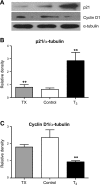Thyroid hormone drives fetal cardiomyocyte maturation
- PMID: 21974928
- PMCID: PMC3250248
- DOI: 10.1096/fj.10-179895
Thyroid hormone drives fetal cardiomyocyte maturation
Abstract
Tri-iodo-l-thyronine (T(3)) suppresses the proliferation of near-term serum-stimulated fetal ovine cardiomyocytes in vitro. Thus, we hypothesized that T(3) is a major stimulant of cardiomyocyte maturation in vivo. We studied 3 groups of sheep fetuses on gestational days 125-130 (term ∼145 d): a T(3)-infusion group, to mimic fetal term levels (plasma T(3) levels increased from ∼0.1 to ∼1.0 ng/ml; t(1/2)∼24 h); a thyroidectomized group, to produce low thyroid hormone levels; and a vehicle-infusion group, to serve as intact controls. At 130 d of gestation, sections of left ventricular freewall were harvested, and the remaining myocardium was enzymatically dissociated. Proteins involved in cell cycle regulation (p21, cyclin D1), proliferation (ERK), and hypertrophy (mTOR) were measured in left ventricular tissue. Evidence that elevated T(3) augmented the maturation rate of cardiomyocytes included 14% increased width, 31% increase in binucleation, 39% reduction in proliferation, 150% reduction in cyclin D1 protein, and 500% increase in p21 protein. Increased expression of phospho-mTOR, ANP, and SERCA2a also suggests that T(3) promotes maturation and hypertrophy of fetal cardiomyocytes. Thyroidectomized fetuses had reduced cell cycle activity and binucleation. These findings support the hypothesis that T(3) is a prime driver of prenatal cardiomyocyte maturation.
Figures







Similar articles
-
Mid-gestation ovine cardiomyocytes are vulnerable to mitotic suppression by thyroid hormone.Reprod Sci. 2012 Jun;19(6):642-9. doi: 10.1177/1933719111432860. Epub 2012 Mar 14. Reprod Sci. 2012. PMID: 22421446 Free PMC article.
-
Thyroid hormone inhibits proliferation of fetal cardiac myocytes in vitro.J Endocrinol. 2007 Feb;192(2):R1-8. doi: 10.1677/JOE-06-0114. J Endocrinol. 2007. PMID: 17283226
-
Thyroid hormone receptor function in maturing ovine cardiomyocytes.J Physiol. 2019 Apr;597(8):2163-2176. doi: 10.1113/JP276874. Epub 2019 Mar 20. J Physiol. 2019. PMID: 30770568 Free PMC article.
-
Regulation of the cardiomyocyte population in the developing heart.Prog Biophys Mol Biol. 2011 Jul;106(1):289-99. doi: 10.1016/j.pbiomolbio.2010.11.010. Epub 2010 Dec 13. Prog Biophys Mol Biol. 2011. PMID: 21147149 Free PMC article. Review.
-
Thyroid hormone signaling and consequences for cardiac development.J Endocrinol. 2019 Jul 1;242(1):T145-T160. doi: 10.1530/JOE-18-0704. J Endocrinol. 2019. PMID: 31117055 Free PMC article. Review.
Cited by
-
Porcine reproductive and respiratory virus 2 infection of the fetus results in multi-organ cell cycle suppression.Vet Res. 2022 Feb 21;53(1):13. doi: 10.1186/s13567-022-01030-3. Vet Res. 2022. PMID: 35189966 Free PMC article.
-
Cardiomyocyte Proliferation from Fetal- to Adult- and from Normal- to Hypertrophy and Failing Hearts.Biology (Basel). 2022 Jun 8;11(6):880. doi: 10.3390/biology11060880. Biology (Basel). 2022. PMID: 35741401 Free PMC article. Review.
-
Maturation of Stem Cell-Derived Cardiomyocytes: Foe in Translation Medicine.Int J Stem Cells. 2021 Nov 30;14(4):366-385. doi: 10.15283/ijsc21077. Int J Stem Cells. 2021. PMID: 34711701 Free PMC article. Review.
-
Synergistic effects of hormones on structural and functional maturation of cardiomyocytes and implications for heart regeneration.Cell Mol Life Sci. 2023 Aug 5;80(8):240. doi: 10.1007/s00018-023-04894-6. Cell Mol Life Sci. 2023. PMID: 37541969 Free PMC article. Review.
-
Binucleation of cardiomyocytes: the transition from a proliferative to a terminally differentiated state.Drug Discov Today. 2014 May;19(5):602-9. doi: 10.1016/j.drudis.2013.10.019. Epub 2013 Oct 31. Drug Discov Today. 2014. PMID: 24184431 Free PMC article. Review.
References
Publication types
MeSH terms
Substances
Grants and funding
LinkOut - more resources
Full Text Sources
Other Literature Sources
Research Materials
Miscellaneous

